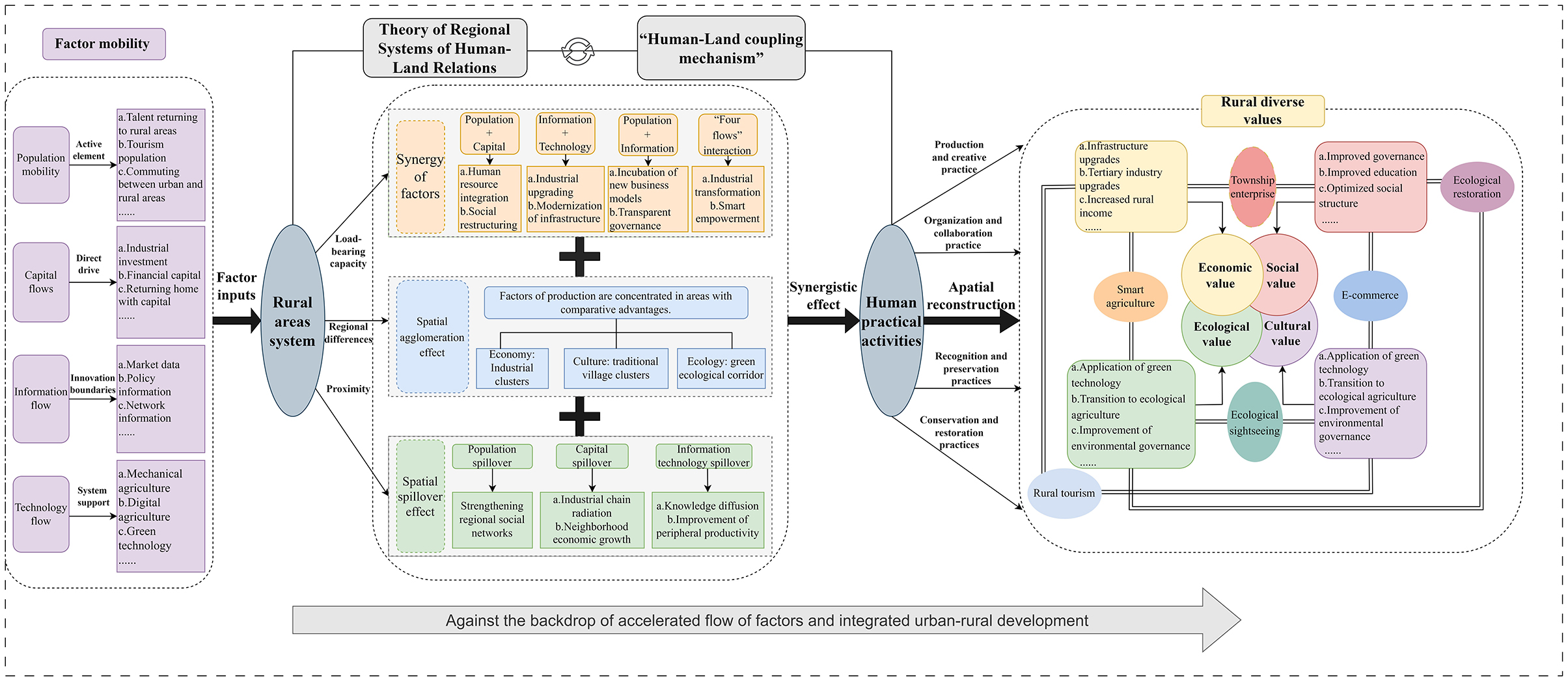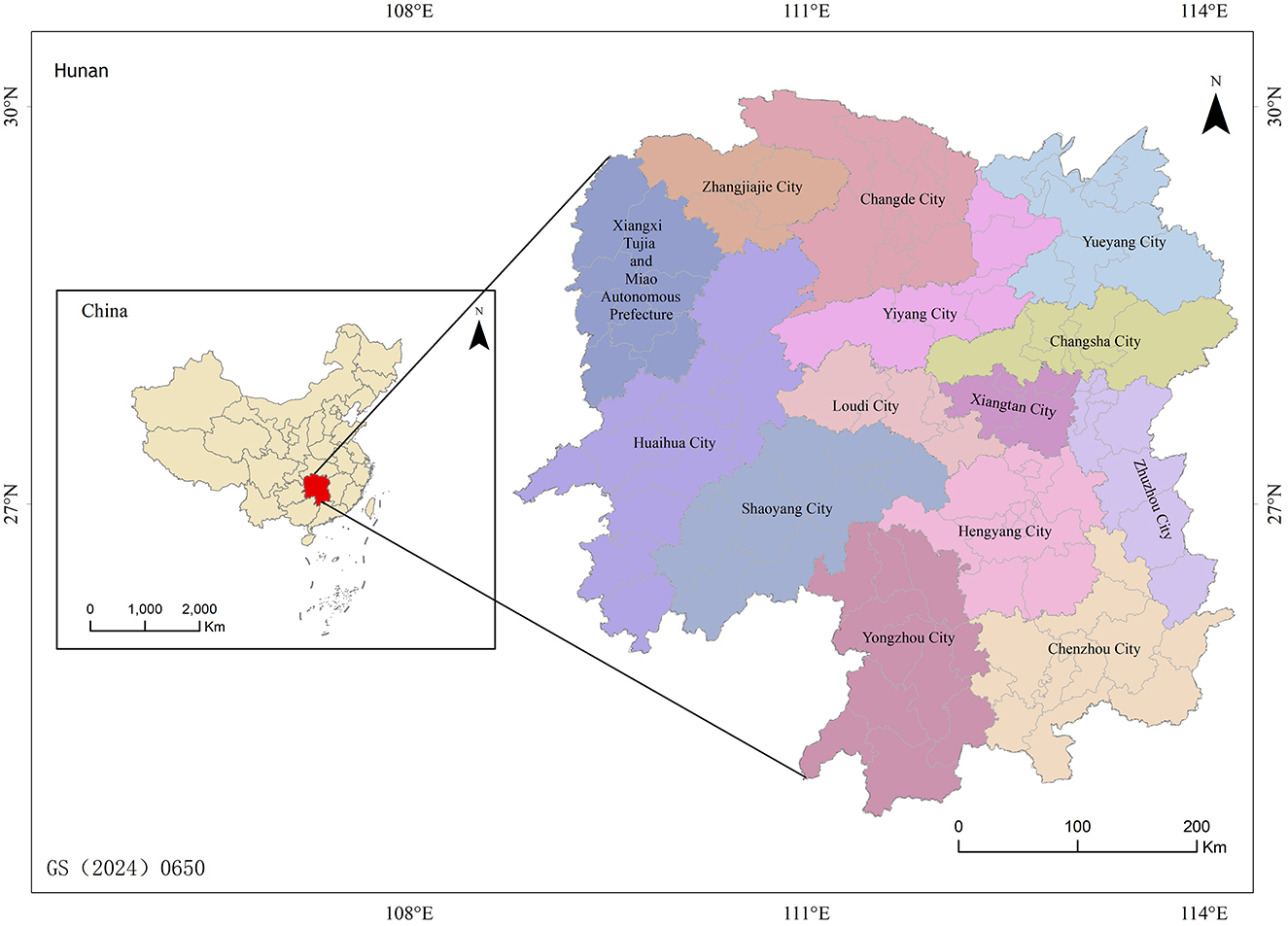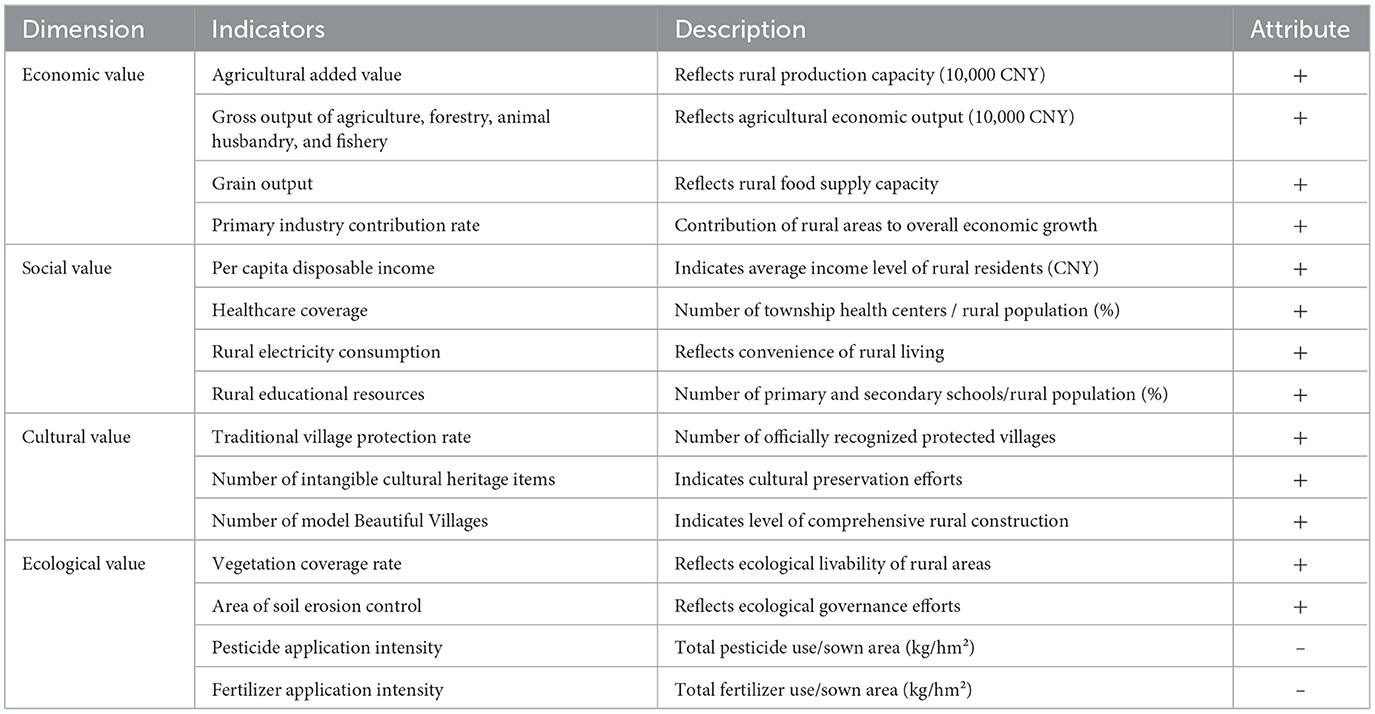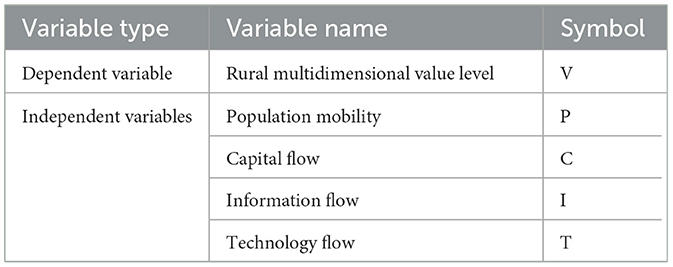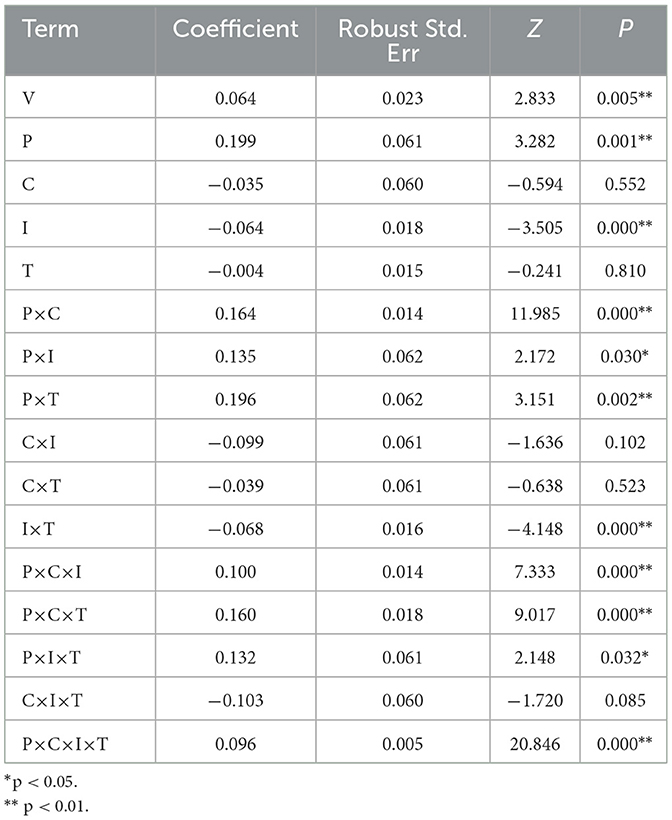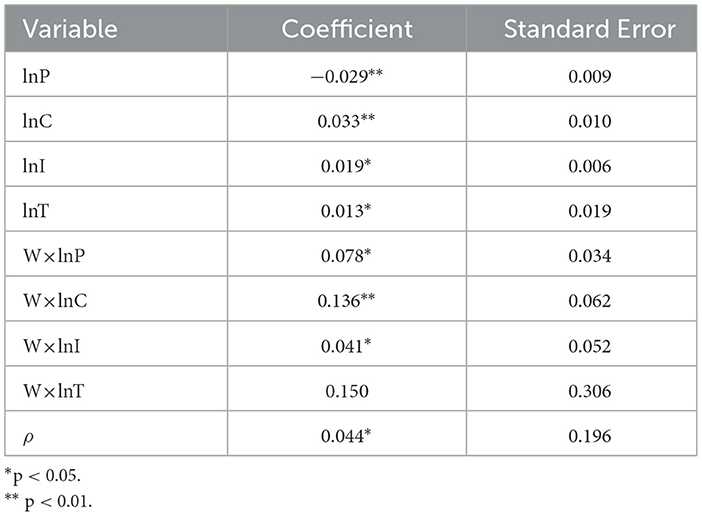- College of Resources, Hunan Agricultural University, Changsha, China
The reconstruction of the rural multi-dimensional values of the countryside in the context of factor mobility is a key path to promote the integrated development of urban and rural areas. A dynamic panel model and a spatial Durbin model were employed to analyze the synergistic, agglomeration, and spillover effects of four key factors—population, capital, information, and technology—on the evolution of rural diverse values, with a focus on Hunan Province. The primary conclusions of the study are as follows: (1) A substantial synergistic effect exists among the factors, with the driving effect strengthening as interactions increase; the strongest synergy occurs when all four factors interact. (2) Factor mobility exhibits clear spatial agglomeration effects, reinforcing resource concentration in advantageous regions and reshaping internal value distribution within those regions. (3) Factor mobility also shows significant spatial spillover effects, where elements in core regions positively influence the enhancement of rural diversified values in surrounding areas. (4) The synergistic effects of these elements establish the value foundation, agglomeration effects form growth poles, and spillover effects drive regional linkage. The synergy of these three effects collectively effects the trajectory for enhancing rural value. This study contributes to the advancement of understanding regarding how factor flows promote rural value enhancement and offers empirical evidence to inform optimized allocation of urban-rural factors and policies for rural revitalization in Hunan Province.
1 Introduction
Rural areas serve as a foundational pillar of Chinese civilization (Long et al., 2019; Liu et al., 2023). Beyond their traditional roles in agricultural production and habitation, they are vital to cultural continuity, ecological preservation, and social stability—making them indispensable components of national development (Hediger and Knickel, 2009). However, as market mechanisms deepen and urbanization accelerates, core production factors such as labor, land, and capital have increasingly gravitated toward urban centers (Liu et al., 2010; Peng et al., 2011). This unidirectional concentration has left many rural regions facing long-standing challenges of factor outflow and demographic hollowing (Wen et al., 2023). Compounding the issue, the intrinsic value of the countryside—particularly in non-economic domains—remains difficult to quantify or marketize, leading to its marginalization (Andreas et al., 2020). Consequently, rural development often falls into a structural trap of economic weakening, value invisibility, and functional deficiency (Yin et al., 2022).
Against this backdrop, advancing urban-rural integration and fully implementing the rural revitalization strategy have become central to China's national development agenda (Wang et al., 2023b). China has acknowledged the pressing nature of these challenges, underscoring the strategic significance of rural value reconstruction. In November 2021, the Ministry of Agriculture and Rural Affairs underscored the mounting importance of rural economic, ecological, social, and cultural values. The 2022 No. 1 Central Document further encouraged local governments to explore and activate the multi-dimensional value of rural areas. These objectives align closely with the United Nations' 2030 Sustainable Development Goals (SDGs) (The United Nations: 2030 Sustainable Development Goals Agenda., 2021), particularly the goal of building “sustainable cities and communities” through enhanced urban-rural linkages (Assembly, 2015; Parnell, 2016). Facilitating the rational flow of multiple factors—including population, capital, information, and technology—between urban and rural regions is not only essential for stimulating rural economies but also for unlocking endogenous potentials in cultural confidence, ecological restoration, and social resilience (Peng et al., 2021; Riazi, 2024; Mónus and Lorincz, 2025; Yu et al., 2025). Such flows are increasingly regarded as a critical pathway to redress the rural value imbalance (Shakya and Vagnarelli, 2024). Understanding the mechanisms by which factor flows influence rural multi-dimensional value—and how these effects vary across space and time—is therefore essential, both as a response to China's strategic goals and as a contribution to global sustainable development discourse (Liu et al., 2020; Bhattacharyya et al., 2025).
In recent years, research on rural value has evolved from basic functional identification toward integrated evaluation and transformation models (Liang et al., 2025). Scholars have examined its underlying logic, influencing mechanisms, and enhancement pathways through case studies, theoretical modeling, and empirical analyses (Ma and Swinton, 2011; Bole et al., 2013; Su et al., 2022). These studies consistently highlight that rural multi-dimensional value plays a pivotal role in promoting urban-rural integration, optimizing rural spatial configurations, and advancing agricultural modernization (Yang et al., 2023). It is also increasingly viewed as a cornerstone for achieving rural revitalization and inclusive prosperity. Simultaneously, factor flow has emerged as a key driver in the evolution of urban-rural dynamics. Drawing on theories of spatial mobility and urban-rural interaction, prior research has investigated the mechanisms and trajectories of labor, land, capital, and information flows (Liu et al., 2022b; Zhu et al., 2024; Chen et al., 2025). However, few studies have systematically analyzed how factor flows dynamically reshape rural multi-dimensional value—particularly through mechanisms such as synergy, spatial agglomeration, and spillover effects. The lack of integrated empirical and theoretical research on this interaction has left a significant gap in understanding how factor mobility contributes to rural transformation under urban–rural integration.
To address this gap, this study investigates the mechanisms by which factor flows influence rural multi-dimensional value in Hunan Province, a central Chinese region characterized by diverse rural types, strong spatial disparities, and active factor exchanges (Bohua et al., 2016; Jianhe et al., 2020; Ying et al., 2021; Huiqing and Fusheng, 2022). Using county-level data from 2012 to 2022, this study employs dynamic panel and spatial Durbin models to investigate three core mechanisms: synergistic effects among factors, spatial agglomeration of rural value, and inter-regional spillovers. Unlike previous research focusing on individual factors or static analyses, the main contribution is an integrated framework combining synergy, agglomeration, and spillover effects to comprehensively explain rural value enhancement under factor mobility. Spatial econometric methods at the county scale reveal significant clustering and spillover patterns among population, capital, information, and technology. This study aims to provide empirical evidence supporting policies for optimized factor allocation, rural revitalization, and balanced regional development.
2 Theoretical framework and research hypotheses
“The Theory of the Man–land Relationship System” emphasizes the dynamic interactions between human activities and the geographical environment (Wu, 2008; Friis et al., 2016; Sheng and Fan, 2018). Within this context, the theory of factor flow identifies the movement of production elements as a key mechanism in reshaping regional systems through the coupling of human and environmental systems (Wang et al., 2018; Jin et al., 2021). Therefore, a theoretical framework was proposed to elucidate the relationship between factor mobility and multidimensional value enhancement in rural areas. The fundamental logic of the aforementioned framework can be succinctly summarized as a sequential mechanism, which is outlined as follows: “factor input—human-land synergy—practice-oriented structural adjustment—multidimensional value enhancement.” (Figure 1). Under the backdrop of accelerated factor mobility and integrated urban–rural development, the orderly flow of key elements—including population, capital, information, and technology—deeply embeds into rural space through man–land coupling processes (Liu et al., 2022a; Ma et al., 2023; Wang et al., 2024). This phenomenon gives rise to an internal dynamic system characterized by factor synergy, spatial agglomeration, and spatial spillover. As these flows interact with rural practices, they collectively foster the emergence of a multi-dimensional, synergistic, and systemically coupled rural value structure. This structure not only facilitates rural value enhancement but also offers theoretical support for advancing urban–rural integration.
The transformation of rural multi-dimensional value is not driven by isolated factor movements, but rather by the synergistic interactions among population, capital, information, and technology. For instance, rural population return necessitates infrastructure development, which in turn relies on capital investment. Similarly, the flow of information accelerates the introduction of new technologies, enabling industrial upgrading. The dissemination of information and the application of technology are mutually reinforcing. Population movements alter rural social structures, while technology, capital, and information flows reshape production methods, lifestyles, and cultural transmission mechanisms, thereby facilitating the modernization and innovation of rural culture and enhancing overall value. Accordingly, Research Hypothesis H1 is proposed: Factor flows exhibit synergistic effects that jointly promote the enhancement of rural multi-dimensional value.
The spatial agglomeration of rural multi-dimensional value fundamentally results from the reconfiguration of resource allocation and value creation mechanisms through factor flows. In the context of urban–rural integration, key elements such as capital and information increasingly transcend geographic boundaries, flowing at higher frequencies and larger scales. This drives the convergence of resources into areas with comparative advantages, resulting in spatially concentrated value formation. Factor flows not only promote the physical clustering of value-generating elements but also establish a functional spatial network that enhances value synergy, thereby acting as an internal force guiding rural spatial restructuring and value agglomeration. Accordingly, Research Hypothesis H2 is proposed: Factor flows produce spatial agglomeration effects that drive the clustering of high-value rural areas.
Changes in the flows of capital, technology, population, and information influence not only local rural value evolution but also extend their effects across regional boundaries. Capital flows, through industrial investment and market expansion, foster local industrial upgrading while exerting spillover effects that stimulate economic growth in adjacent areas. Technology diffusion, via knowledge transmission and innovation, enhances productivity locally and through labor mobility and cooperation, elevates technological capacity in surrounding regions. Furthermore, population movements—particularly labor return and talent inflow—not only revitalize the local economy but also catalyze socio-cultural and economic activities in neighboring rural areas. Accordingly, Research Hypothesis H3 is proposed: Factor flows generate spatial spillover effects that promote rural value enhancement in neighboring areas.
3 Materials and methods
3.1 Study area
Hunan Province is located in central China along the middle reaches of the Yangtze River, enjoying a distinctive geographical advantage as a strategic hub that bridges eastern and western regions while connecting the north and south. It serves as a critical fulcrum for China's “Rise of Central China” strategy and as a core region for major national initiatives, including the high-quality development of the Yangtze River Economic Belt. The province comprises 122 county-level administrative units; however, since Furong District has reached an urbanization rate of 100% and lacks substantive rural space, it was excluded from the analysis. Consequently, 121 counties were selected as the study units (Figure 2). Hunan is a major agricultural province characterized by an extensive rural territory and a large rural population base (Zhou et al., 2021). By the end of 2023, the province had a permanent population of 65.70 million, of which 25.51 million—approximately 38.84%—resided in rural areas, underscoring the continued demographic and spatial significance of the countryside. The per capita disposable income of urban and rural residents was 49,243(CNY) and 20,921(CNY), respectively, yielding an income ratio of 2.35. The Engel coefficients stood at 28.5% for urban households and 30.3% for rural households, reflecting persistent urban-rural disparities in living standards and consumption patterns. In recent years, driven by the rural revitalization strategy and policies promoting regional coordination, Hunan has witnessed an accelerated flow of production factors, deepening industrial integration, and a gradual narrowing of its dual economic structure (Tan et al., 2023). These trends have created both momentum and opportunities for reconstructing rural multi-dimensional value through enhanced factor mobility, while fostering new dynamics in urban-rural integration. Taken together, Hunan's diverse rural spatial typologies, active factor flows, and heterogeneous development foundations render it an ideal and representative case for examining the mechanisms through which factor flows influence rural value enhancement.
3.2 Research methods
3.2.1 Entropy weight method
Based on the connotation of rural multi-dimensional value and drawing on relevant academic studies, an indicator system was constructed from four dimensions: economic, social, cultural, and ecological, comprising a total of 16 indicators (Table 1) (Zhang et al., 2022; Dou and Wang, 2023; Wang et al., 2023a; Jia et al., 2024). In line with the theoretical framework, four key production factors—population, capital, information, and technology—were selected to evaluate the intensity of factor flows (Table 2).
The entropy weight method was employed to calculate the indicator weights for each year from 2012 to 2022. The average value of these annual weights was then used as the final weight to compute the composite scores of rural multidimensional value and factor flow intensity. The calculation formula is as follows:
Where V represents the rural multidimensional value score, F denotes the intensity of factor flow, is the normalized value of the indicator, and wj is the weight calculated using the entropy method.
3.2.2 Dynamic panel model
To explore the synergistic effects among different factor flows on rural multidimensional value evolution, a dynamic panel model was constructed (Table 3) (Bond, 2002). This model incorporates the key factor flow variables—population (P), capital (C), information (I), and technology (T)—as well as their second-, third-, and fourth-order interaction terms. To mitigate potential multicollinearity from higher-order interaction terms, all variables were mean-centered before constructing interactions. VIF tests confirmed that values were below 10, indicating no multicollinearity concerns. The model is specified as follows:
Where Vit is the lagged term, μi denotes the individual (county-level) fixed effect, λt represents the time fixed effect, εit is the error term, (Pit+Cit) represents the interaction terms, including second-order, third-order, and fourth-order interactions.
3.2.3 Spatial Durbin model
To systematically assess the spatial agglomeration and spillover effects of factor flows on rural multidimensional value, this study adopts the Spatial Durbin Model (SDM) (Mur and Angulo, 2006; Lee and Yu, 2016) for empirical analysis. The model includes spatial lags of both dependent and independent variables, allowing simultaneous estimation of local and neighboring spillover effects. A spatial adjacency matrix based on contiguity was constructed to define county-level spatial relationships. The model is specified as follows:
Where Vit denotes the level of rural multidimensional value in county i at time t; represents the vector of urban–rural factor flows, including four dimensions: population, capital, information, and technology; w is the spatial weight matrix; ρ captures the spatial lag effect of the dependent variable; θ reflects the spatial spillover effects of the explanatory variables; μi and λi are region and time fixed effects, controlling for unobserved spatial heterogeneity and temporal shocks, respectively; εit is the error term.
3.3 Data sources
(1) Socio-economic data, including agricultural added value, are from the Hunan Statistical Year book, Hunan Rural Statistical Year book (2013–2023), and the Hunan Statistical Bulletin; (2) intangible cultural heritage data are sourced from the China Intangible Cultural Heritage Network and Digital Museum (https://www.ihchina.cn/); (3) traditional village data come from the Ministry of Housing and Urban-Rural Development's List of Traditional Chinese Villages for Protection; (4) “Beautiful Villages” data are from the Hunan Department of Agriculture and Rural Affairs' provincial model village list; (5) vegetation coverage data derive from China's 250-meter resolution dataset (2000–2023) by the National Tibetan Plateau Data Center; (6) the Digital Inclusive Finance Index is provided by Peking University's Digital Finance Research Center.
To ensure comparability across indicators with different units and scales, all quantitative variables were standardized. For variables with skewed distributions, logarithmic transformation was applied to reduce heteroscedasticity and improve normality. Time series data underwent smoothing to mitigate short-term fluctuations, and missing values were handled using linear interpolation methods.
4 Results and analysis
4.1 Verification of factor synergy effects
Table 4 presents the estimation results of the dynamic panel model. At the level of main effects, population mobility exerts a significantly positive impact on rural multidimensional value (Coefficient = 0.199, p < 0.01), indicating that population return plays a crucial role in replenishing rural labor, restoring social capital, and reconstructing identity. In contrast, the main effects of capital flow and technological support are statistically insignificant, suggesting that their isolated impacts are insufficient to drive value enhancement. Information connectivity shows a significant negative coefficient at the 1% level, revealing a mismatch between information input and the rural absorption capacity, potentially due to issues such as information fragmentation, resource misallocation, or institutional gaps.
Second-order interaction results show that P × C (population × capital), P × I (population × information), and P × T (population × technology) are all significantly positive at the 5% level, indicating clear synergistic effects between population flow and other factors. For instance, P × C has a coefficient of 0.164 (p < 0.001), demonstrating that population return supported by capital boosts rural industrial vitality and value output. P × T's coefficient reaches 0.196, highlighting strong synergy that facilitates transformation of production modes and rural social functions. However, some interaction terms—such as I × T (information × technology)—are significantly negative, suggesting possible substitution effects or inefficiencies. This implies that disproportionate technological input without matching improvements in information access, or vice versa, may cause resource misallocation and reduce marginal returns, weakening the overall value-enhancing effect.
Furthermore, third-order and fourth-order interaction terms were introduced to test the effects of multi-factor linkages. The results show that the interaction terms P × C × I, P × C × T, P × I × T, and the four-way interaction P × C × I × T are all significantly positive at the 5% level or better. Notably, the coefficient for P × C × I × T reaches 0.096 with the highest t-value (p < 0.001), indicating that the joint driving effect of population, capital, information, and technology is the most significant. This reveals a typical “multiplicative” structural reconstruction mechanism, in which higher levels of synergy among factors correspond to stronger impacts on rural multidimensional value. According to resource integration and coupling theories, interacting factors produce combined effects greater than their sum, creating a multiplier that drives rural development by enhancing coordination, innovation, and resource use. These findings confirm Hypothesis H1.
4.2 Verification of spatial agglomeration effects
To identify the spatial agglomeration characteristics of rural multidimensional value and factor flows, this study constructed graded overlay maps using data from 2012, 2017, and 2022 to visualize the spatial distribution of rural multidimensional value and the intensity of various factor flows (Figure 3). The maps reveal a certain degree of temporal and spatial coordination between the two. From 2012 to 2022, the overall intensity of factor flows in Hunan Province shifted from a “moderate-speed” to a “high-speed” level, while the spatial pattern evolved from “eastern concentration” to “province-wide expansion.” In the early stages, factor flows were primarily concentrated in the Chang-Zhu-Tan urban agglomeration and northeastern Hunan. With the implementation of regional development policies and improvements in transportation infrastructure, the central and southwestern regions experienced a steady rise in factor flow intensity, forming a multi-core flow pattern radiating from Chang-Zhu-Tan to the north and south-central areas. Correspondingly, rural multidimensional value also exhibited a continuous upward trend, marked by a significant increase in the number of high-value areas and a transition from scattered to clustered spatial distribution. In 2012, high-value areas were mainly located in the central-western part of Hunan. By 2017, these areas had expanded to the northwest and southern parts of the province. By 2022, multiple stable growth poles of high rural value had emerged, covering a wide area with an increasingly optimized hierarchical structure. These observations suggest a preliminary spatial consistency between factor flows and rural multidimensional value in terms of agglomeration.
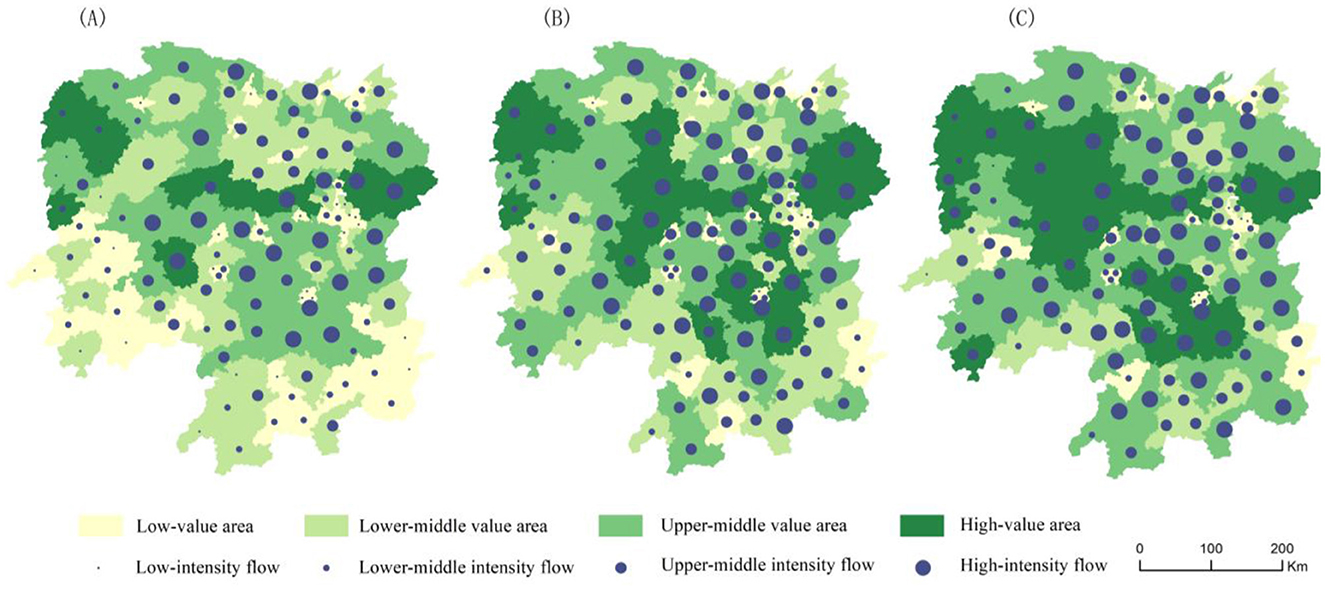
Figure 3. Diagram of the synergistic evolution of rural multi-dimensional value and factor flows. (A) 2012, (B) 2017, (C) 2022.
Furthermore, a hot spot–cold spot analysis was conducted to examine the spatial patterns of growth rates in rural multidimensional value and factor flows across counties in Hunan from 2012 to 2022 (Figure 4). The results show a strong alignment between the hot spot regions of rural value growth and the regions with high rates of factor flow change. These hot spots were mainly located in the southern and southwestern parts of the province, where flows of capital, information, and technology were also more dynamic. This suggests that active factor flows have significantly contributed to the growth of rural multidimensional value. In contrast, cold spots were primarily concentrated in central and northern Hunan, which also showed relatively low rates of change in capital flow, information exchange, and technical support, indicating potential constraints in factor mobility that may hinder rural value enhancement.
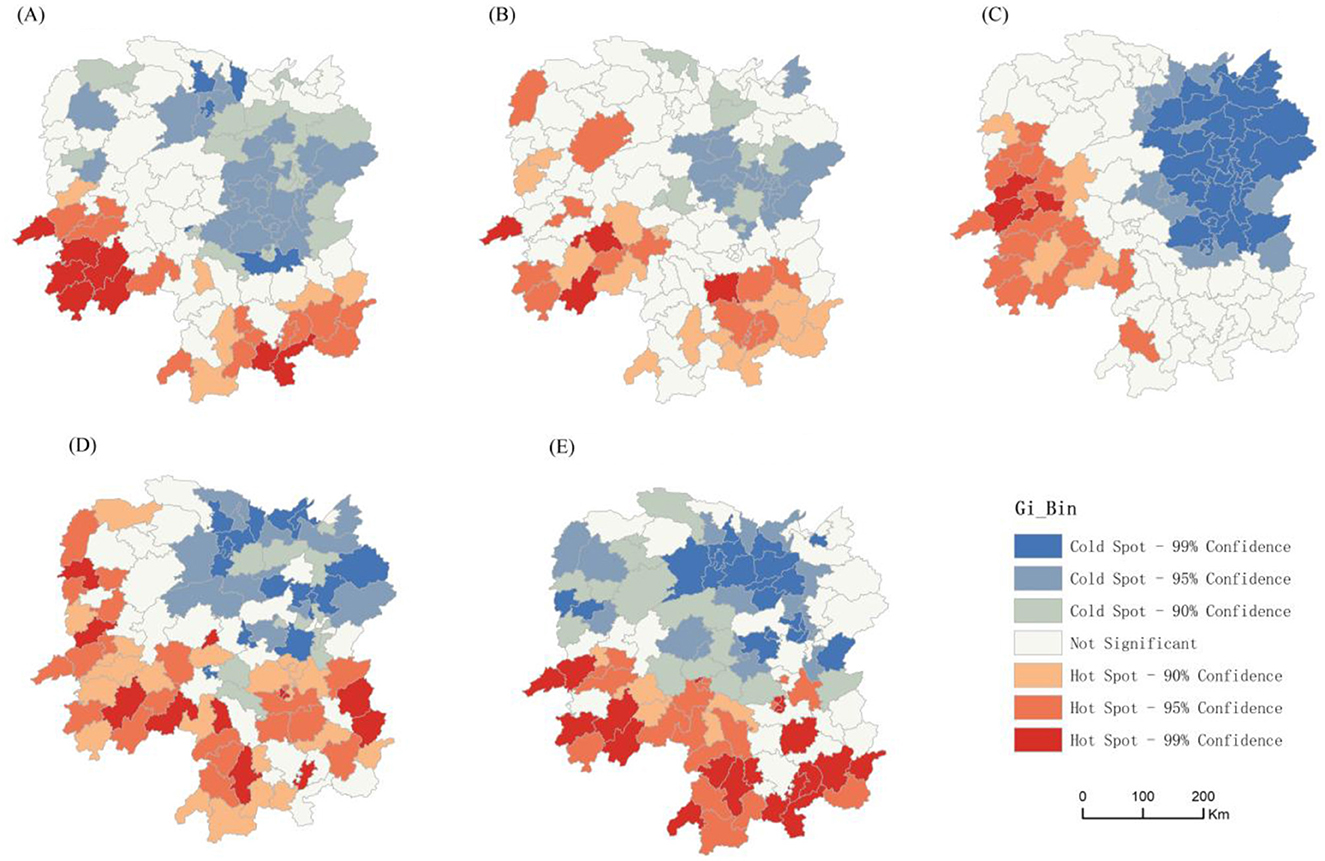
Figure 4. Hot–cold Spot of the change rates of rural comprehensive value levels and factor flows in Hunan Province (2012–2022). (A) Change rate of rural multidimensional value. (B) Change rate of rural population mobility. (C) Change rate of rural capital flow. (D) Change rate of information flow. (E) Change rate of technology flow.
Finally, to further verify whether this agglomeration trend is driven by factor flows, a Spatial Durbin Model (SDM) was employed, incorporating various factor flow intensity variables and their spatial lag terms. The results (Table 5) show that the spatial lag coefficient (ρ) is significantly positive at the 1% level, with the spatial lag terms for population and information flows also being significant. This indicates that these two factors play dominant roles in the spatial agglomeration mechanism. Overall, the spatial evolution of rural multidimensional value in Hunan has shifted from “dispersed growth” to “high-value clustering,” driven by the frequent spatial flows and interactive coupling of population, capital, and information. These findings provide empirical support for Hypothesis H2.
4.3 Verification of spatial spillover effects
The regression results of the Spatial Durbin Model (Table 5) indicate that the spatial autoregressive coefficient (ρ) is 0.044, significant at the 10% level, confirming the existence of spatial dependence in the rural multidimensional value level across Hunan Province. Regarding the spatial spillover effects of explanatory variables, the coefficients of the spatial lag terms W × lnP, W × lnC and W × lnI are significant at the 5, 10, and 10% levels, respectively. This suggests that rural population inflow, capital investment, and information exchange exhibit significant spatial spillover effects. Specifically, population inflow can indirectly benefit neighboring rural areas through financial remittances, the transfer of experience and technology, and enhanced urban-rural interactions. Capital flow contributes to rural infrastructure improvements and fosters regional development through collaborative investment. The spatial effect of information flow likely stems from its rapid transmission and low spatial constraints. In contrast, the coefficient of the spatial lag term for technology flow (W × lnT) is not significant, implying that the spatial spillover effect of technology is relatively weak, potentially due to difficulties in promoting agricultural technologies across regions.
To more accurately assess the impact of spatial spillover effects on the development of rural multidimensional value, the partial differential decomposition method was employed to distinguish direct, indirect, and total effects (Table 6). The direct effect of population (lnP) is significantly negative at the 10% level, while the indirect effect is significantly positive at the 5% level. This indicates that population mobility indirectly contributes to the enhancement of rural value. Although rural depopulation may reduce local labor supply, it can increase per capita resource availability and promote land-use intensification. Moreover, a portion of the population, such as government-assigned graduates, grassroots officers, and technical personnel, may move from urban to rural areas, where their integration with other production factors contributes positively to rural development.
For capital (lnC), the direct, indirect, and total effects are all significant, suggesting that capital flow has a pronounced positive impact on rural multidimensional value. Economic capital serves as the foundation for rural development, and capital inflow into rural areas significantly enhances economic, social, cultural, and ecological values. In contrast, the direct effects of information (lnI) and technology (lnT) are not significant; however, their indirect effects are significantly positive at the 5% level. This implies that although information and technology alone may not directly drive rural value enhancement, they can have an indirect effect when integrated with other factors such as human capital and financial resources. These results provide empirical support for Hypothesis H3.
5 Discussion
This study advances the understanding of how factor mobility influences rural multidimensional value by integrating dynamic and spatial perspectives. Unlike prior research that analyzed factors in isolation, the results reveal that rural transformation is driven by high-order synergies among population, capital, information, and technology. The significant four-way interaction effect reflects a multiplicative mechanism, extending theoretical frameworks beyond additive models and underscoring the necessity of integrated factor governance. Spatial analysis further indicates heterogeneity in factor effects: clustering of factor flows generates high-value growth poles, while positive spillovers—particularly from population and capital—facilitate the co-evolution of rural value across regions. Similar patterns can be seen in international cases such as the “Chiikki Okoshi Kyorykutai” program in Japan and the Rural Integration Policy of the European Union (Michalcewicz-Kaniowska and Zajdel, 2019; Zollet and Qu, 2024). These plans similarly emphasize the promotion of rural revitalization through the coordinated flow of factors and the narrowing of the gap between urban and rural areas.
From a long-term perspective, sustained factor mobility in Hunan is likely to reinforce spatial clustering in core regions and strengthen diffusion channels benefiting peripheral areas. If current trends persist, high-value growth poles may consolidate their regional leadership roles, fostering broader interconnection among rural areas. However, without adjustments to balance factor distribution, the process may also exacerbate spatial polarization. These findings extend spatial development theory by linking factor mobility to value diffusion dynamics and by demonstrating that multi-factor interactions are central to understanding the temporal and spatial trajectories of rural transformation.
Despite these contributions, certain limitations should be acknowledged. The use of composite indices may obscure informal mechanisms such as social networks and cultural capital. And some indicators derived from official statistics—e.g., intangible cultural heritage, traditional villages, or 250 m vegetation coverage—may underestimate informal cultural assets or micro-scale ecological changes. The spatial Durbin model is also limited in capturing non-linear dynamics or network-based interactions. Future research could integrate spatial network analysis, agent-based modeling, household surveys, or social network metrics to explore dynamic feedback loops and micro-level processes driving rural value transformation.
6 Conclusion
This study investigates the mechanisms by which factor flows—namely population, capital, information, and technology—influence the evolution of rural multi-dimensional value in Hunan Province from 2012 to 2022. Using a dynamic panel model and a spatial Durbin model, the study reveals the following key findings:
(1) The enhancement of rural multi-dimensional value is primarily driven by the interaction among multiple factor flows. The results confirm that population mobility, when combined with capital investment, technological application, and information exchange, produces significant multiplicative effects, with the four-way interaction (P × C × I × T) showing the strongest positive impact.
(2) The spatial clustering of factor flows—especially population and capital—plays a crucial role in forming regional value growth poles. High-value rural areas tend to emerge in regions with strong industrial bases and infrastructure, such as the Chang-Zhu-Tan urban agglomeration and the Dong ting Lake Plain.
(3) Factor flows not only enhance local rural value but also generate significant positive spillovers across adjacent regions. Spatial lag terms in the Durbin model show that population return, capital inflows, and information diffusion contribute to interregional value co-evolution. However, the spillover effect of technology remains limited, likely due to institutional barriers and localization of application.
(4) The findings suggest a three-layered mechanism in which synergy among factors builds the value foundation, agglomeration shapes spatial concentration, and spillovers facilitate cross-regional diffusion. Together, these mechanisms construct a dynamic pathway for rural value enhancement in the context of urban–rural integration.
Based on the research findings and the practical needs of rural revitalization in Hunan Province, several policy recommendations are proposed. First, a systematic mechanism should be established to promote the return of key production factors—such as capital, talent, information, and technology—from urban to rural areas. These factors need to be effectively embedded and transformed into high-value local assets through industrial alignment and institutional support, fostering a shift toward innovation-driven rural development. Second, core areas such as the Chang-Zhu-Tan urban agglomeration and the Dong ting Lake Plain should serve as spatial anchors to drive rural value through spillover effects. Enhancing public services, digital infrastructure, and governance capacity in these regions will further strengthen their role as growth poles. Third, inter-regional coordination should be improved to build a unified urban–rural factor market. Strengthening cross-regional cooperation in industry, knowledge, and talent flows will support integrated development and a multi-nodal rural network. Finally, region-specific development strategies should be adopted. The Chang-Zhu-Tan area may focus on innovation and integration, the Dongping Lake region on ecological agriculture, and remote areas such as the Wuling Mountains and southern Hunan on public service improvement and the utilization of cultural–ecological resources.
Data availability statement
Publicly available datasets were analyzed in this study. This data can be found here: (1) Socio-economic data such as agricultural added value are obtained from the Hunan Statistical Yearbook, Hunan Rural Statistical Yearbook (2014–2023), and the Statistical Bulletin of Hunan Province; (2) Data on the number of intangible cultural heritage items are sourced from the official website of the China Intangible Cultural Heritage Network and the China Intangible Cultural Heritage Digital Museum (https://www.ihchina.cn/); (3) Data on traditional villages are derived from the List of Traditional Chinese Villages for Protection, issued by the Ministry of Housing and Urban-Rural Development of China; (4) Data on “Beautiful Villages” come from the List of Provincial-Level Model Villages for Beautiful Countryside Construction, published by the Department of Agriculture and Rural Affairs of Hunan Province; (5) Vegetation coverage data are obtained from the 250-meter vegetation coverage dataset (2000–2023) for China, released by the National Tibetan Plateau Data Center; (6) The Digital Inclusive Finance Index is sourced from the Peking University Digital Inclusive Finance Index, published by the Digital Finance Research Center of Peking University.
Author contributions
QL: Writing – original draft, Writing – review & editing, Conceptualization, Methodology, Supervision. RZ: Writing – original draft, Writing – review & editing, Data curation, Formal analysis, Software. HR: Writing – review & editing, Methodology, Supervision, Writing – original draft. LT: Writing – review & editing, Resources, Supervision. QX: Writing – review & editing, Validation.
Funding
The author(s) declare that financial support was received for the research and/or publication of this article. This work was supported by the Humanities and Social Sciences Planning Fund of the Ministry of Education of China (24YJA630052) and the Natural Science Basic Research Plan in Shaanxi Province of China (Grant No. 2024JC-YBQN-0265).
Conflict of interest
The authors declare that the research was conducted in the absence of any commercial or financial relationships that could be construed as a potential conflict of interest.
Generative AI statement
The author(s) declare that no Gen AI was used in the creation of this manuscript.
Any alternative text (alt text) provided alongside figures in this article has been generated by Frontiers with the support of artificial intelligence and reasonable efforts have been made to ensure accuracy, including review by the authors wherever possible. If you identify any issues, please contact us.
Publisher's note
All claims expressed in this article are solely those of the authors and do not necessarily represent those of their affiliated organizations, or those of the publisher, the editors and the reviewers. Any product that may be evaluated in this article, or claim that may be made by its manufacturer, is not guaranteed or endorsed by the publisher.
References
Andreas, J., Kale, S. S., Levien, M., and Zhang, Q. F. (2020). Rural land dispossession in China and India. J. Peasant Stud. 47, 1109–1142. doi: 10.1080/03066150.2020.1826452
Assembly, U. G. (2015). Transforming our world: the 2030 agenda for sustainable development. Available online at: https://policycommons.net/artifacts/18386159/transforming-our-world/19286553/ (accessed July 18, 2025).
Bhattacharyya, S., Burman, R. R., Padaria, R. N., Paul, S., Venkatesh, P., Datta, A., et al. (2025). The models and the aspiring models: assessing the sustainable rural development philosophy and reality in India through multi-dimensional indices. Front. Sustain. Food Syst. 9:1561399. doi: 10.3389/fsufs.2025.1561399
Bohua, L., Sha, Y., Peilin, L., and Yindi, D. O. U. (2016). Spatial distribution of traditional villages and influence factors in Hunan province. J. Landsc. Res. 8, 63–67. doi: 10.16785/j.issn1943-989x.2016.2.019
Bole, D., Pipan, P., and Komac, B. (2013). Cultural values and sustainable rural development: a brief introduction. Acta Geogr. Slov. 53, 367–370. doi: 10.3986/AGS53401
Bond, S. R. (2002). Dynamic panel data models: a guide to micro data methods and practice. Port. Econ. J. 1, 141–162. doi: 10.1007/s10258-002-0009-9
Chen, W., Jiang, J., and Li, L. (2025). Spatio-temporal evolution patterns of flow space and its impact on urban-rural construction land transformation: a case study of the yellow river basin. Sustain. Futur. 9:100474. doi: 10.1016/j.sftr.2025.100474
Dou, H., and Wang, C. (2023). Rural multi-values empowered by rural-urban factor flow: a case studyof Chongqing of China. Trans. Chin. Soc. Agric. Eng. 39, 207–216. doi: 10.11975/j.issn.1002-6819.202302017
Friis, C., Nielsen, J. Ø., Otero, I., Haberl, H., Niewöhner, J., and Hostert, P. (2016). From teleconnection to telecoupling: taking stock of an emerging framework in land system science. J. Land Use Sci. 11, 131–153. doi: 10.1080/1747423X.2015.1096423
Hediger, W., and Knickel, K. (2009). Multifunctionality and sustainability of agriculture and rural areas: a welfare economics perspective. J. Environ. Policy Plan. 291–313. doi: 10.1080/15239080903412453
Huiqing, C., and Fusheng, Z. (2022). Level measurement and regional difference of agricultural and rural modernization development in Hunan province. Econ. Geogr. 42, 185–194. doi: 10.15957/j.cnki.jjdl.2022.11.020
Jia, A., Yun, X., Zheng, X., Wen, X., Liang, X., and Yun, Y. (2024). Towards sustainable rural revitalization: a multidimensional evaluation of rural vitality in China's traditional villages. Sustainability 16:5408. doi: 10.3390/su16135408
Jianhe, X., Yongmei, Y. U. E., Zhou, M. A. O., and Su, L. I. U. (2020). Influencing factors and protection modes of the spatial pattern of traditional villages in Hunan province. Econ. Geogr. 40, 147–153. doi: 10.15957/j.cnki.jjdl.2020.10.017
Jin, B., Yang, W., Li, X., Sha, J., and Wang, X. (2021). A literature review on the space of flows. Arab. J. Geosci. 14:1294. doi: 10.1007/s12517-021-07632-z
Lee, L., and Yu, J. (2016). Identification of spatial durbin panel models. J. Appl. Econom. 31, 133–162. doi: 10.1002/jae.2450
Liang, J., Fu, X., and Zhang, A. (2025). The research progress on agricultural spatial reconstruction and regional functional transformation: theoretical pathways and multi-scale coordination mechanisms. Geogr. Res. Bull. 4, 375–378. doi: 10.50908/grb.4.0_375
Liu, S., Guan, Y., Chen, W., and Peng, Z. (2023). The transformation of rural areas located in China's agricultural heritage systems under the evolution of Urban-Rural relationships. Sustainability 15:16408. doi: 10.3390/su152316408
Liu, S., Ma, L., Yao, Y., and Cui, X. (2022a). Man-land relationship based on the spatial coupling of population and residential land-A case study of Yuzhong County in Longzhong Loess Hilly Region, China. Land Use Policy 116:106059. doi: 10.1016/j.landusepol.2022.106059
Liu, Y., Liu, Y., Chen, Y., and Long, H. (2010). The process and driving forces of rural hollowing in China under rapid urbanization. J. Geogr. Sci. 20, 876–888. doi: 10.1007/s11442-010-0817-2
Liu, Y., Zang, Y., and Yang, Y. (2020). China's rural revitalization and development: theory, technology and management. J. Geogr. Sci. 30, 1923–1942. doi: 10.1007/s11442-020-1819-3
Liu, Y., Zhang, X., Xu, M., Zhang, X., Shan, B., and Wang, A. (2022b). Spatial patterns and driving factors of rural population loss under urban-rural integration development: a micro-scale study on the village level in a hilly region. Land 11:99. doi: 10.3390/land11010099
Long, H., Zhang, Y., and Tu, S. (2019). Rural vitalization in China: a perspective of land consolidation. J. Geogr. Sci. 29, 517–530. doi: 10.1007/s11442-019-1599-9
Ma, L., Zhang, Y., Gan, M., and Shan, Z. (2023). Rethinking man-land relations in China: a multidisciplinary perspective. Land 12:1606. doi: 10.3390/land12081606
Ma, S., and Swinton, S. M. (2011). Valuation of ecosystem services from rural landscapes using agricultural land prices. Ecol. Econ. 70, 1649–1659. doi: 10.1016/j.ecolecon.2011.04.004
Michalcewicz-Kaniowska, M., and Zajdel, M. (2019). Rural development in European Union policy. Econ. Sci. Rural Dev. 50, 140–146. doi: 10.22616/ESRD.2019.017
Mónus, G., and Lorincz, L. (2025). Rural-urban flows determine internal migration structure across scales. Cities 163:105992. doi: 10.1016/j.cities.2025.105992
Mur, J., and Angulo, A. (2006). The spatial durbin model and the common factor tests. Spat. Econ. Anal. 1, 207–226. doi: 10.1080/17421770601009841
Parnell, S. (2016). Defining a global urban development agenda. World Dev. 78, 529–540. doi: 10.1016/j.worlddev.2015.10.028
Peng, C., Ma, B., and Zhang, C. (2021). Poverty alleviation through e-commerce: village involvement and demonstration policies in rural China. J. Integr. Agric. 20, 998–1011. doi: 10.1016/S2095-3119(20)63422-0
Peng, X., Chen, X., and Cheng, Y. (2011). Urbanization and its consequences. Paris Fr. Eolss Publ. 2, 1–16.
Riazi, I. (2024). Urban-rural linkages: improving regional development through enhanced connectivity. Kashf J. Multidiscip. Res. 1, 19–26. Available online at: https://kjmr.com.pk/kjmr/article/view/85 (Accessed August 30, 2025).
Shakya, M., and Vagnarelli, G. (2024). Creating value from intangible cultural heritage-The role of innovation for sustainable tourism and regional rural development. Eur. J. Cult. Manag. Policy 14:12057. doi: 10.3389/ejcmp.2024.12057
Sheng, K., and Fan, J. (2018). The formation mechanism of regional function:an analysis based on the theory of man-earth areal system. Econ. Geogr. 38, 11–19. doi: 10.15957/j.cnki.jjdl.2018.05.002
Su, K., Wu, J., Yan, Y., Zhang, Z., and Yang, Q. (2022). The functional value evolution of rural homesteads in different types of villages: evidence from a Chinese traditional agricultural village and homestay village. Land 11:903. doi: 10.3390/land11060903
Tan, X., Wang, Z., An, Y., and Wang, W. (2023). Types and optimization paths between poverty alleviation effectiveness and rural revitalization: a case study of hunan province, China. Chin. Geogr. Sci. 33, 966–982. doi: 10.1007/s11769-023-1377-6
The United Nations: 2030 Sustainable Development Goals Agenda. (2021). The Role of Monitoring and Evaluation in the UN 2030 SDGs Agenda (Cham: Springer International Publishing), 1–41. doi: 10.1007/978-3-030-70213-7_1
Wang, C., Liang, X., Dou, H., and Huang, Y. (2023a). Spatio-temporal evolution and driving mechanism of non-grain cultivated landfor rural multi-value realization: a case study of chongqing. Econ. Geogr. 43, 144–153. doi: 10.15957/j.cnki.jjdl.2023.04.015
Wang, R., Shi, J., Hao, D., and Liu, W. (2023b). Spatial-temporal characteristics and driving mechanisms of rural industrial integration in China. Agriculture 13:747. doi: 10.3390/agriculture13040747
Wang, S., Fu, B., Zhao, W., Liu, Y., and Wei, F. (2018). Structure, function, and dynamic mechanisms of coupled human-natural systems. Curr. Opin. Environ. Sustain. 33, 87–91. doi: 10.1016/j.cosust.2018.05.002
Wang, Y., Lu, Y., and Zhu, Y. (2024). Can the integration between urban and rural areas be realized? A new theoretical analytical framework. J. Geogr. Sci. 34, 3–24. doi: 10.1007/s11442-024-2192-4
Wen, Q., Li, J., Ding, J., and Wang, J. (2023). Evolutionary process and mechanism of population hollowing out in rural villages in the farming-pastoral ecotone of Northern China: a case study of Yanchi County, Ningxia. Land Use Policy 125:106506. doi: 10.1016/j.landusepol.2022.106506
Wu, C. (2008). Theoretical study and regulation of the territorial system of human-land relations. Ournal Yunnan Normal University Social Science Education, Kunming, Yunnan, China, 1–3.
Yang, W., Li, W., and Wang, L. (2023). How should rural development be chosen? The mechanism narration of rural regional function: a case study of Gansu Province, China. Heliyon 9:e20485. doi: 10.1016/j.heliyon.2023.e20485
Yin, X., Chen, J., and Li, J. (2022). Rural innovation system: revitalize the countryside for a sustainable development. J. Rural Stud. 93, 471–478. doi: 10.1016/j.jrurstud.2019.10.014
Ying, X., Lihua, H., Fang, Z., Dandan, Z., and Yanli, T. (2021). Multifunctional spatial characteristics of rural areas and their type identification based on county scale: a case of Hunan Province. Econ. Geogr. 41, 162–170. doi: 10.15957/j.cnki.jjdl.2021.06.018
Yu, H., Qubi, W., and Luo, J. (2025). Digital transformation in agricultural supply chains enhances green productivity: evidence from provincial data in China. Earths Future 13:e2025EF006089. doi: 10.1029/2025EF006089
Zhang, J., Huang, B., Chen, X., Zhu, C., and Gan, M. (2022). Multidimensional evaluation of the quality of rural life using big data from the perspective of common prosperity. Int. J. Environ. Res. Public. Health 19:14166. doi: 10.3390/ijerph192114166
Zhou, G., Yu, X., He, Y., Chen, Y., and Bi, F. (2021). Thoughts on The effective connection between consolidating the achievements of poverty alleviation and rural revitalization in Hunan province. Econ. Geogr. 41, 10–18. doi: 10.15957/j.cnki.jjdl.2021.08.002
Zhu, X., Cao, H., and Guo, S. (2024). Evaluation of urban-rural total factor flow efficiency based on multiple symbiosis: insights from 27 provinces in China. Sustainability 16:5385. doi: 10.3390/su16135385
Keywords: factor flows, rural multi-dimensional value, synergistic effect, spatial agglomeration, spatial spillover, sustainable rural development
Citation: Liu Q, Zhao R, Ren H, Tian L and Xie Q (2025) Unveiling the mechanisms of factor flows in enhancing rural multi-dimensional values: a case study of Hunan Province, China. Front. Sustain. Food Syst. 9:1673254. doi: 10.3389/fsufs.2025.1673254
Received: 25 July 2025; Accepted: 25 August 2025;
Published: 11 September 2025.
Edited by:
Liye Wang, Shandong University of Finance and Economics, ChinaReviewed by:
Zhang Yue, Henan Agricultural University, ChinaChenning Deng, Chinese Research Academy of Environmental Sciences, China
Copyright © 2025 Liu, Zhao, Ren, Tian and Xie. This is an open-access article distributed under the terms of the Creative Commons Attribution License (CC BY). The use, distribution or reproduction in other forums is permitted, provided the original author(s) and the copyright owner(s) are credited and that the original publication in this journal is cited, in accordance with accepted academic practice. No use, distribution or reproduction is permitted which does not comply with these terms.
*Correspondence: Hui Ren, MTQ5NDc4NTkyQHFxLmNvbQ==
 Qing Liu
Qing Liu Ru Zhao
Ru Zhao